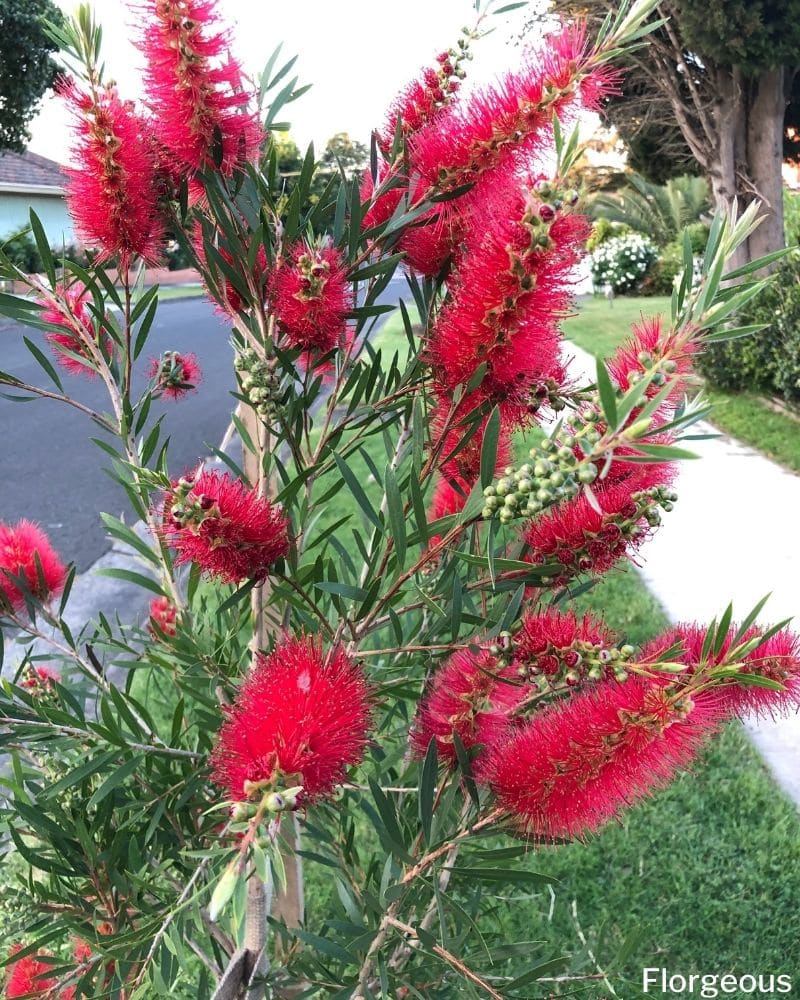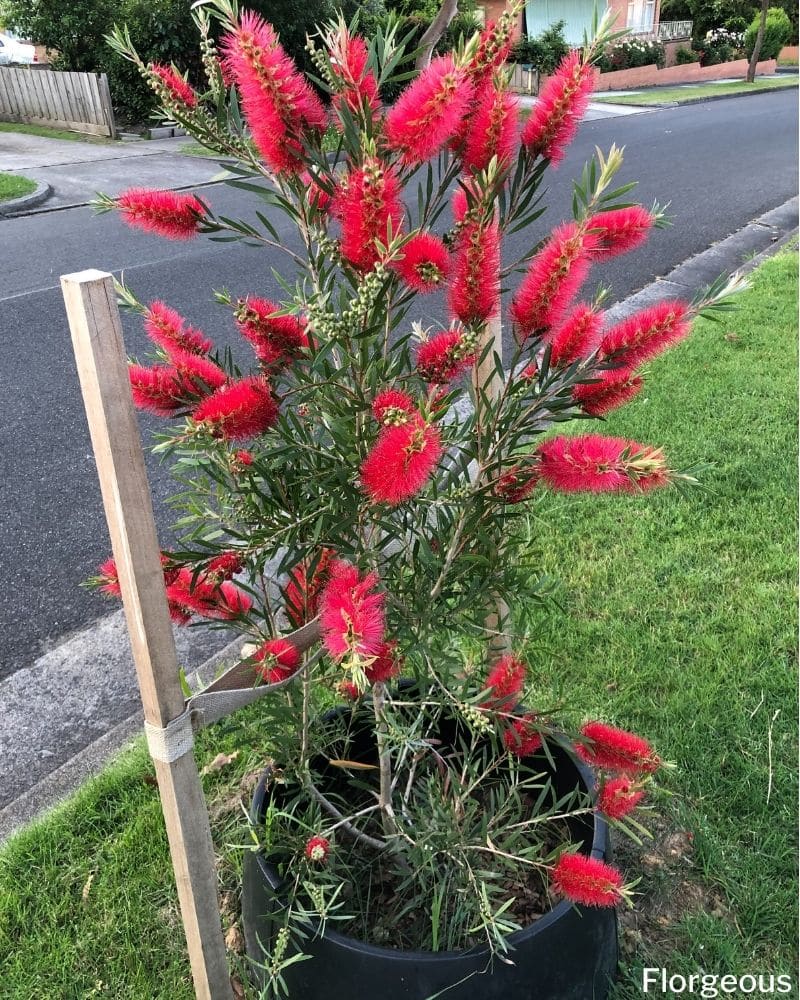Bottlebrush trees are large showy evergreen shrubs or small trees that hummingbirds and other pollinators just love.
If you live in a warm enough area and have the space to grow one or more of these, they would certainly make a valuable contribution to the look and feel of your landscape.
What Is A Bottlebrush Plant?
Bottlebrush plants are from the Myrtaceae family and take their names from their interesting, bottlebrush-like flowers. These plants are of the genus Melaleuca, although they are still sometimes referred to by their old name, Callistemon.
There are nearly 300 species known in the genus and growth forms vary betweenausshrubs and tall trees. In this article, we’ll cover two of the most popular gardening options.

Bottlebrush Species
Crimson Bottlebrush (Melaleuca citrina)
This plant, which is also often called the lemon bottlebrush, and was previously known as Callistemon citrinus, is an Australian shrub that can reach up to 15 ft (4.5 m) tall and wide. These plants can be grown in USDA hardiness zones 9 to 11.
They have elongated leaves that grow to about 4 inches (10 cm) long and have a lovely lemon fragrance. Crimson bottlebrush flowers in spring and occasionally in the fall, and develops small round and woody fruits.
Weeping Bottlebrush (Melaleuca viminalis)
This species, which was previously known as Callistemon viminalis is also commonly known as the creek bottlebrush. This is a taller plant that can reach heights of over 20 ft (6 m), and is also an Australian native.
The plant gets its name for its graceful, willow-like hanging branches. Grow these plants in USDA hardiness zones 9 to 11.
Popular Bottlebrush Varieties
- ‘White Anzac’ is a low but wide growing variety of M. citrina that reaches heights of around 5 ft (1.5 m) and produces white flowers.
- ‘Burgundy’ is a purple-flowering form of M. citrina. These plants stay at a manageable size and don’t grow taller than about 10 ft (3 m).
- ‘Reeves Pink’ is a pink-flowered form of M. citrina that grows to about 10 ft (3 m) tall.
- ‘Mauve Mist’ is a hardy variety of M. citrina that has light purple flowers and grows to 12 ft tall (3.5 m).
- ‘Captain Cook’ is a dwarf variety of M. viminalis that stays at a very manageable size of 6 ft (1.8 m) tall or less and about 5 ft (1.5 m) wide.
- ‘Little John’ is a very popular dwarf variety that stays compact at around 3 ft (0.9 m) tall and 5 ft (1.5 m) wide.
Bottlebrush Flowers

Bottlebrush flowers occur in dense, cylindrical spikes with small, inconspicuous petals and long, well-developed filaments and styles. Bottlebrush flowers are usually red in appearance although yellow, pink, purple, and white flowers also occur.
After flowering, small rounded woody fruits are produced containing many seeds. These fruits persist on the plants for many years and seeds are usually not released until after a few years.
How To Grow A Bottlebrush Tree

Water
Bottlebrush trees are drought tolerant, but they still need water to grow well. In the early stages of development, water your plant frequently to help it establish itself. You can test the topsoil and apply water when you notice that it has become dry.
Apply water until the plant matures. You should water your plant every day in the first week of planting during a period of no rain. Take extra caution and water the plants slowly to make sure the root system thoroughly get saturated. When watering, be sure to wet the area around the root ball entirely.
Over time, you can reduce your water application to two or three times per week.
After one month, you can leave your container plants to depend on rain when it is comfortable. Excessively applying water will keep the soil too moist, eventually causing root rot fungus to attack the plant and its neighbors. If this happens, you will notice yellowing leaves and dying back branches.
Sunlight
Bottlebrush plants are sun loving specimens, and providing them with ample sunlight is crucial for their optimal growth. Plant them in a location that receives full sun, ensuring they get at least six to eight hours of direct sunlight daily.
Sun exposure promotes robust flowering and maintains the plant’s overall health. In regions with scorching summers, some afternoon shade can be beneficial to prevent stress on the plant.
Soil
Use a well-draining mix of charcoal, sphagnum, and perlite. Bottlebrushes do not like to be in soil that is too wet, so it is important to ensure that the soil is well-draining. Additionally, it is important to keep the soil moist to ensure optimal growth conditions for the plant.
Temperature and Humidity
Bottlebrush shrubs can withstand high temperatures but prefer low humidity. Maintain temperatures between 60-75°F. Keep high humidity, around 50-70%.
Fertilizer
Although not necessary if grown in a fairly fertile, loamy soil, an application of a low-phosphorous fertilizer in early spring and fall will be beneficial to these plants and may increase flowering. Feed with a balanced orchid fertilizer every 2 weeks.
Care and Maintenance
Bottlebrushes need little pruning but when necessary, should be pruned in early summer after the main flowering season since flower buds occur on the ends of new shoots. Harder pruning of old-growth is very possible with these plants but should be done over a period of two or 3 years ideally.
Although not necessary if grown in a fairly fertile, loamy soil, an application of a low-phosphorous fertilizer in spring and fall will be beneficial to these plants and may increase flowering. (2)Additionally, it is important to keep the soil moist to ensure optimal healthy growth conditions for the plant.
These bottlebrush shrubs are generally pest and disease resistant. Chlorosis of the leaves can affect plants grown in alkaline potting soil. Root rot can affect plants grown in soil with inadequate drainage.

Uses
Horticultural Uses
More upright growing species of Melaleuca can be grown as an attractive and colorful informal hedge, or screen. The weeping bottlebrush is a great small tree for Mediterranean gardens.
Human Uses
Aboriginal Australians make use of the timber of these plants for a variety of applications.
Wildlife Uses
Bottlebrush plant flowers attract hummingbirds, butterflies, and bees, but are not attractive to deer.
FAQs
How do you keep a bottle brush alive?
To keep a bottlebrush (Callistemon) alive, check the soil moisture daily and provide it with full direct sunlight. Water regularly, especially during dry periods, and avoid waterlogged conditions. Prune the tree occasionally to maintain its shape and remove any dead or diseased growth.
Why is my bottlebrush dying?
Bottlebrush trees may decline for various reasons, including overwatering, poor soil drainage, pests, or diseases. Assess the plant’s environment, ensuring it has well-draining soil, and adjust watering practices accordingly. Check for signs of pests or diseases, and promptly address any issues to promote the tree’s health.
What kills bottle brush?
Bottlebrush trees can be susceptible to various pests and diseases, such as scale insects, aphids, and fungal infections. To protect your bottlebrush, regularly inspect the plant for any signs of infestation or disease. Treat any issues promptly with appropriate pesticides or fungicides, following recommended guidelines.
What are the disadvantages of bottle brush tree?
Disadvantages of bottlebrush trees include their potential invasiveness in some regions, where they may spread rapidly and outcompete native vegetation. Additionally, the litter of fallen flowers and spent bristles can create maintenance challenges. Some people may also find the shedding of bark and leaves to be a drawback. Before planting, it’s essential to be aware of the tree’s growth habits and potential impact on the local ecosystem.
Conclusion
In summary, successful bottlebrush care involves providing ample sunlight, well-draining soil, and consistent watering. Regular pruning enhances the plant’s shape and encourages new growth. With these simple yet crucial steps, enthusiasts can enjoy a vibrant and resilient bottlebrush plant in their garden.
For more shrubs to grow, check our list of bushes.
References
Reference List:
(1) Toogood, A. Propagation: The Fully Illustrated Plant-By-Plant Manual Of Practical Techniques.
(2) Harvey, R. Bottlebrush- Genus Callistemon.
Close







